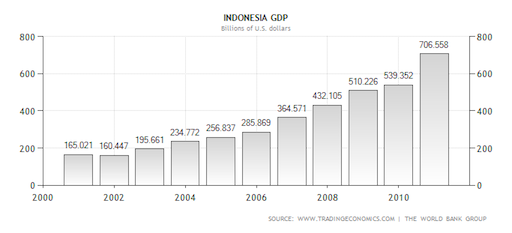I’ve long been fascinated by Indonesia. Since my brother learned the language in high school and took a bus trip to Darwin and a flight onto Yogyakarta sometime in the late 80s. Obviously since then we’ve seen the rise of the bogan traveller to Bali, the horror of radical Islamic-led bali bombings, the soap opera around Schapelle Corby and everything in between. I assume that many of these events are at the front of mind of many Australians when they think of Indonesia which is why the country gets so little economic attention.
What is interesting, however, is that Indonesia is a nation of 240 million people who quite literally live on our door-step and over recent years, unbeknown to most, has been quietly growing in economic strength.
I guess given our Anglo-centric universe this is somewhat expected, but as investors it is inexcusable. That point aside, what interests me most is that in recent times Indonesia has become one of the beacons of hope in the otherwise bleak landscape of economics.
To the average Ozzie , through the eyes of the mainstream media, Indonesia presents as obscure country governed by a corrupted government with little to no understanding of modern capitalism. The problem, however, is that this view has very little to do with the country that is the modern Indonesia. You only need to take a look at the country’s recent growth indicators to realise something very interesting is happening, and if you aren’t involved you are missing out:

And if charts aren’t enough to move you from the 1990’s prism in which most Australians view the northern neighbour, then maybe a view of Jakarta’s sky line may help you make the adjustment:

But if even that picture doesn’t inspire you to re-think some part of your portfolio then maybe the numbers will:
Indonesian economy is predicted to grow by 6.8 percent to 7.2 percent next year, spurred by investment and consumption, Coordinating Minister for Economy Hatta Rajasa said here on Thursday.
Hatta Rajasa said that investment would contribute to the growth by 3.03 percent to 3.13 percent, followed by household consumption by 2.62 percent to 2..85 percent.
Previously the government forecast the economy to grow by 6.7 percent to 7 percent next year, according to Hatta.
The central bank on Thursday kept the key interest rate unchanged at 5.75 percent for the third straight month to help spur economic growth as inflation pressure persists.
The bank cut the basic rate by 25 basis points in February and 50 basis points at the end of last year.
Indonesia foreign direct investment rose by 30.3 percent to 51. 5 trillion rupiah (some 5.6 billion U.S. dollar) in the first quarter year on year following the second credit rating upgrade to investment grade by Moody’s on Jan. 18, Gita Wirjawan, chairman of the country’s investment coordinating board has said.
Indonesia is targeting 206.8 trillion rupiah (some 22.43 billion U.S. dollar) in foreign direct investment this year, 18 percent higher than that of last year, he has said.
I’m not suggesting Indonesia is without risk, every investment always is, but while the western world is trying hard just to tread water, it’s difficult to argue with something starting with a 6. This obviously leads onto the big questions. If Indonesia is looking at growth in the high single digits then why won’t it be dethroning others. Some suggest it is:
As India fails to deliver on its promise of growth, a smaller Asian country Indonesia, finds itself in a position to lure investors away from the third largest economy in the region with higher stock market returns, better fiscal management and lower inflation.
“Indonesia looks like it has hit the sweet spot, whereas India is nursing a headache from its latest boom,” says Frederic Neumann, Co-Head of Asian Economic Research at HSBC.
While the two economies aren’t similar in terms of size, with India’s population of 1.2 billion and Indonesia’s at 240 million, the countries share many similarities, leading to comparisons. Both have a burgeoning consumer base and are democracies with an investment grade rating.
India’s economy has hit a rough spot with the slowest pace of growth in three years with the government unable to deliver on economic reforms. On the other hand, Indonesia has won favor with investors over the past few years.
That’s leading Neumann and others to call for Indonesia to be included in the lineup of top global emerging markets. “The term BRICs really misses out on some of the key developments of our time. Indonesia has solid public finances, strong growth, a burgeoning consumer market, and plenty of resources to keep the economy afloat for many years,” says Neumann.
And it doesn’t appear that the domestic economy is Indonesia’s only strength:
Besides delivering better returns, Indonesia is also catching up with India when it comes to economic growth. India’s gross domestic product (GDP) is expected to expand at just under 7 per cent in the current fiscal year, which began April 1, while Indonesia is expected to deliver 6 to 7 per cent growth over the next couple of years, say analysts.
Even on trade, Indonesia scores over India. According to brokerage CLSA’s latest forecast Indonesia’s current account deficit in 2012 will be just 0.8 per cent of GDP, while India’s will come in at around 3.9 per cent.
Rajeev Malik, Senior Economist at CLSA, says in Indonesia’s case, net Foreign Direct Investment (FDI) will offset the current account deficit. In India’s case, he points out, an estimated net FDI inflow of USD 15-20 billion will be well short of the current account deficit.
“They are doing better although they are not as big an economy as India,” he says.
I am not an expert on the country, but when much of the western world is struggling to deliver anything on the positive side of zero it is well worth taking the time to investigate the alternatives. As far as I can tell, at this point and given the proximity, Indonesia appears to be an untapped gem to the Australian investor. Some further research is definitely in order.